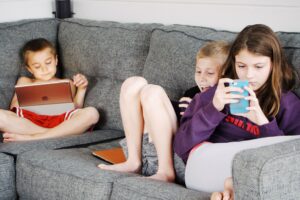For several y ears, All About Eyes has been raising the alarm on the increasing rates of myopia in all age groups, but most especially in children. Myopia—also called near-sightedness or short-sightedness—is when objects in the distance are blurry. Close-up objects are clear. Myopia can be inherited from your parents or, as researchers and eye-care professionals around the world are fast discovering, as a result of looking too long at objects close-up.
ears, All About Eyes has been raising the alarm on the increasing rates of myopia in all age groups, but most especially in children. Myopia—also called near-sightedness or short-sightedness—is when objects in the distance are blurry. Close-up objects are clear. Myopia can be inherited from your parents or, as researchers and eye-care professionals around the world are fast discovering, as a result of looking too long at objects close-up.
With recent studies showing the effects of COVID lockdowns on children’s vision, it’s time—once again—to sound the alarm. Here’s an excerpt from an October 2022 online article by the BBC on the topic:
Data from China already shows that the lockdowns did in fact deal a blow to young children’s eye health. One study compared myopia rates among children, measured by annual screenings. Before the pandemic, in the years from 2015-19, the highest myopia rate measured among six-year-old children was 5.7%. In June 2020, after 5 months of home confinement, researchers measured children’s eyesight in that age group and found that the rate shot up to 21.5%, says David C. Musch, one of the study’s co-authors and a professor of ophthalmology and visual sciences, and epidemiology, at the University of Michigan.
Researchers have referred to this effect as “quarantine myopia”—basically, lockdown-induced short-sightedness.
The World Health Organization (WHO) predicts that half of the world’s population will be myopic by 2050. In the United States alone, rates have risen from 25% of the population having myopia in the 1970s to nearly 42% today. In Asian countries, the rates of myopia have skyrocketed among teenagers and young adults to 90% of that age group being affected. In China, that figure is 97%!
Researchers believe these dramatic, recent increases are due to children spending multiple hours a day, usually indoors, looking at electronic devices: phones, tablets, and computers. The effects of staring at screens and not getting natural light outdoors have dire vision-threatening consequences.
Why the Concern?
Myopia is a gateway to other vision-threatening complications, such as:
- Glaucoma: Myopes are twice as likely to develop open-angle glaucoma according to studies by the National Institutes of Health.
- Cataracts: Children who develop myopia are more likely to have cataracts later in life, according to the Myopia Institute.
- Retinal Detachment: People with myopia have a six-times greater risk of developing retinal detachment. Drs. Cheryl and Dave Roell saw an increase in myopia-related retinal detachment during lockdown as well.
- Macular Degeneration: This is the most serious of the complications resulting from myopia. Macular degeneration is a progressive condition that starts with blurriness and ends (if left untreated) with blindness. Children with myopia are at greater risk for developing macular degeneration later in life.
Combating Myopia
If your child hasn’t had a comprehensive eye exam since the COVID lockdowns, schedule one to make sure that myopia hasn’t developed. Second, make sure they’re getting a couple of hours outside every day, if possible. And finally, if your child does have myopia and needs corrective solutions, we are now offering MySight® contact lenses, which are FDA-approved, as well as Atropine drops as another alternative to slow down myopia in kids.

